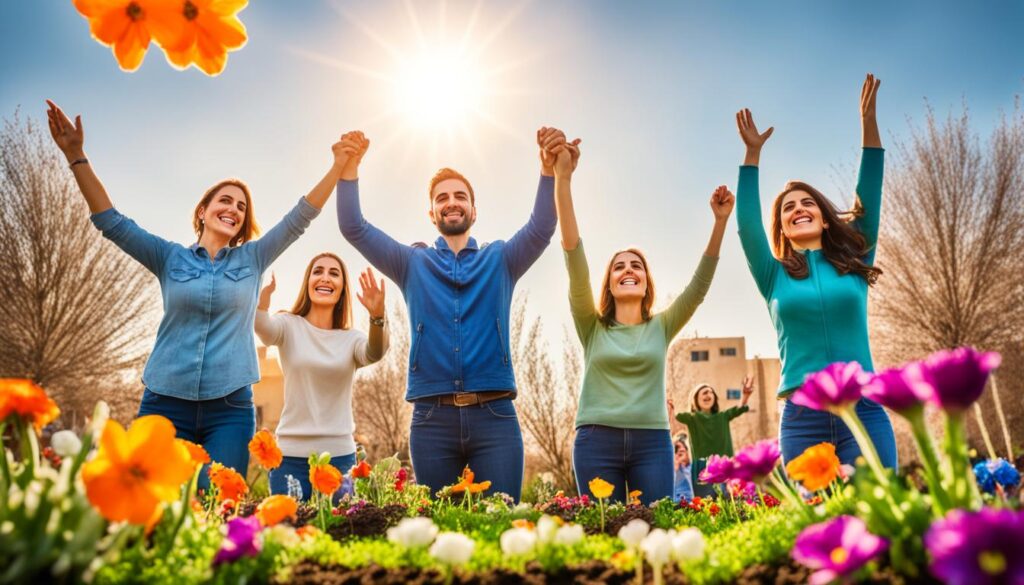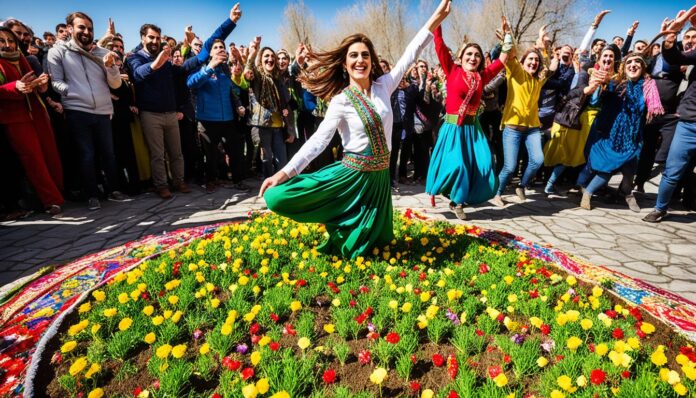As the winter frost finally melts away, and the days grow longer, there’s an undeniable sense of anticipation in the air. It’s a feeling that stirs our hearts and whispers of hope, joy, and new beginnings. This feeling is familiar to millions of people around the world who eagerly await the arrival of Nowruz, the Persian New Year.
Nowruz is not just a date on the calendar; it’s a celebration, a reunion of souls, and a time to honor the beauty of traditions that have spanned millennia. It’s a reminder of our shared humanity and the interconnectedness of cultures across the globe.
Since ancient times, Nowruz has served as a beacon of light in the darkness, a guiding star that leads us out of the wintry gloom and into the embrace of spring. And in 2024, on March 19th, at precisely 11:06 p.m. EDT, we will come together once again to welcome the dawn of a new year.
Nowruz Traditions and Customs
Nowruz, the Persian New Year, is a vibrant celebration that encompasses a rich tapestry of traditions and customs. This cultural extravaganza has been cherished and passed down for centuries, blending history, faith, and the joy of spring’s arrival.
Central to Nowruz is the mesmerizing display of the haft-seen, a ceremonial table adorned with seven symbolic items, all beginning with the letter “s” in Persian. These meticulously chosen objects represent fundamental aspects of life. From rebirth and abundance to love and protection, they evoke a profound sense of appreciation and hope for the future. Picture the shimmer of goldfish swimming in a bowl, the tantalizing fragrance of freshly sprouted wheatgrass, and the allure of decorated eggs placed delicately on the table.
Spring cleaning takes on new meaning as families prepare for the New Year by tidying up their homes, bidding farewell to the past, and embracing the fresh beginning that Nowruz promises. A visit to relatives is customary, as loved ones unite to exchange gifts, share meals, and revel in the delight of each other’s company.
Nowruz is not just a celebration of Persian culture—it’s an extraordinary phenomenon that transcends borders, weaving together diverse communities and fostering a deep sense of unity. As we embrace this cherished festival, let us take a moment to appreciate the beauty of Persian culture, the resilience of its people, and the bountiful traditions that make Nowruz an occasion worth celebrating.
Nowruz is a time for reflection, unity, and celebrating the beauty of Persian culture. It invites us to take a pause, appreciate the wonders of life, and cherish the bonds that connect us all. As the world springs back to life, let us join hands in this cultural celebration, embracing the joyous spirit of Nowruz.

Nowruz Across Ethnic Groups
Nowruz, the Iranian festival of spring, is not confined to Iranians alone. Various ethnic groups across Central Asia, the Middle East, and the Balkans also celebrate Nowruz in their unique ways. From the Pakistani community to the Afghan tradition bearers, and the Kurdish population, Nowruz is a celebration that unites people of different backgrounds and cultural heritage.
For Iranians, Nowruz holds special significance as the most important holiday on their calendar. It is celebrated joyously by the majority of the population, with families coming together to partake in traditional customs and festivities.
Similarly, for the Kurds, Nowruz is considered their national celebration, showcasing their rich cultural heritage. The festival serves as a unifying force, bringing together Kurdish communities from different regions.
Nowruz celebrations among different ethnic groups are marked by their distinct customs and rituals associated with the festival. Pakistani celebrations, for instance, showcase a blend of local traditions and Iranian influences, reflecting the cultural diversity within the community.
Afghanistan, with its diverse ethnic makeup, boasts its own unique Nowruz traditions that vary across different regions. The Afghan people uphold the age-old customs of Haft Mewa, a tradition involving the serving of seven dried fruits with nuts and sweets. This ritual symbolizes the arrival of spring and the abundance it brings.
As for the Kurdish population, Nowruz represents a time of unity, as people from different backgrounds come together to celebrate their shared heritage. The Kurdish celebration of the festival is characterized by lively gatherings, traditional feasts, and performances that reflect their long-standing cultural traditions.
Nowruz, in its essence, transcends political and cultural differences, fostering a sense of unity and camaraderie across various ethnic groups. The festival serves as a reminder of the power of traditions to bring people together and celebrate the beauty of diversity.
The Legend of Nowruz
Nowruz, the vibrant Persian New Year celebration, has ancient roots that trace back to the Zoroastrian religion and the Persian calendar. This momentous festival, believed to have originated around 3,000 years ago, holds deep cultural and historical significance for those who celebrate it. The legend of Nowruz, though varying among ethnic groups, carries a special meaning for the Kurdish community.
In the Kurdish legend of Nowruz, the festival symbolizes the emancipation of their people from the clutches of tyranny. The legend tells the inspiring story of a courageous king who led a rebellion against oppression, signifying freedom and the end of injustice. Nowruz serves as a reminder of the power of resilience and the triumph of good over evil.
The festivities of Nowruz bring people together to celebrate and honor their cultural heritage, embodying the spirit of unity and renewal. This joyous occasion is intricately linked to the Persian calendar, which follows the Earth’s movements around the Sun in a solar-based system. As the first day of spring, Nowruz marks the vernal equinox when day and night are of equal length, symbolizing the balance between light and darkness.
Nowruz transcends borders and ethnicities, fostering a sense of shared humanity. From Iran to Kurdistan and beyond, this cherished festival unites people in celebration, reminding them of their shared values and aspirations. The legend of Nowruz continues to inspire generations, serving as a testament to the resilience of the human spirit and the enduring power of cultural traditions.
Nowruz Celebrations Around the World
Nowruz, the vibrant festival of renewal and spring, is celebrated with joy and enthusiasm in various countries and communities. Let’s take a closer look at some of the unique Nowruz traditions and celebrations around the world:
Afghanistan: Haft Mewa Delights and Buzkashi Thrills
In Afghanistan, Nowruz is marked by indulging in a delightful treat called haft mewa, a mixture of seven dried fruits and nuts symbolizing the coming of spring and abundance. It’s a time for families to gather, share delicious haft mewa treats, and exchange warm wishes. Additionally, a thrilling national sport known as buzkashi takes center stage during the festivities, where horse riders compete to grab a goat carcass and score points. The energy and excitement add an unforgettable element to Nowruz celebrations in Afghanistan.
Azerbaijan: Rituals Representing the Elements
Azerbaijan prepares for Nowruz with rituals held on the four Tuesdays leading up to the celebration. Each Tuesday is dedicated to one of the four elements – water, fire, earth, and wind. These rituals involve traditional practices like bonfires, jumping over fires for purification, washing hands and feet symbolizing cleansing, and planting trees to honor the earth. Azerbaijani communities cherish these rituals as a way of embracing nature and welcoming the new year.
Iran: Elaborate Haft-Seen Tables and Sprouting Traditions
Nowruz festivities in Iran are characterized by the creation of elaborately decorated haft-seen tables. These tables feature seven symbolic items, with each item starting with the Persian letter “s.” The items typically include wheat grass, coins, mirror, garlic, apple, sumac, and vinegar, representing prosperity, wisdom, purity, health, beauty, sunrise, and patience, respectively. Iranian families also take part in the delightful tradition of visiting nature, where they release sprouts into running water as a symbol of renewal and rebirth. These customs add a touch of magic and beauty to Nowruz celebrations in Iran.
Nowruz celebrations truly capture the rich cultural heritage and traditions associated with this joyous festival. Whether it’s savoring Afghan haft mewa, participating in Azerbaijani rituals, or indulging in the Iranian haft-seen tradition, Nowruz brings people together in a spirit of unity and celebration. It’s a time to exchange gifts, share meals, and embrace the unique traditions that make Nowruz such a special and cherished occasion.
Key Takeaways
- Nowruz is the Persian New Year celebrated on the first day of the vernal equinox.
- Nowruz 2024 falls on March 19, 2024, at 11:06 p.m. EDT.
- It is a time for renewal, rebirth, and the celebration of ancient traditions.
- Nowruz is observed by millions of people around the world, transcending borders and uniting cultures.
- Join us in welcoming Nowruz 2024 with open hearts and a zest for life!
Conclusion
Nowruz, the Persian New Year, is a celebration that transcends borders and brings people together from all walks of life. This vibrant festival marks the arrival of spring and is a time of renewal and rebirth. Nowruz 2024 promises to be a joyous and colorful celebration worldwide, symbolizing hope, resilience, and the power of cultural heritage to unite and inspire.
During Nowruz, we have the opportunity to honor ancient traditions and embrace the beauty of Persian culture. It is a time to reflect on the past year, set intentions for the future, and appreciate the richness of our diverse communities. From the setting of the haft-seen table to the joyful gatherings with loved ones, the Nowruz celebration is a testament to the resilience and spirit of humanity.
As we welcome the new year and bid farewell to the cold winter months, let us come together and sprout with excitement and joy. Let us celebrate the Persian New Year, embrace our cultural heritage, and rejoice in the arrival of the spring equinox. Nowruz is a time for unity, love, and appreciation – a time to open our hearts and renew our spirits, setting the stage for a year filled with positivity and growth.
FAQ
What is Nowruz?
Nowruz is the Persian New Year celebrated by millions of people around the world. It marks the arrival of spring and is observed on the first day of the vernal equinox.
When is Nowruz 2024?
Nowruz 2024 will be celebrated on March 19, 2024, at 11:06 p.m. EDT.
What are some Nowruz traditions?
One of the most important customs is the setting of the haft-seen, a ceremonial table decorated with seven symbolic items that all begin with the letter “s” in Persian. Families also engage in spring cleaning, visit relatives, exchange gifts, and participate in communal meals.
Who celebrates Nowruz?
Nowruz is celebrated not only by Iranians but also by various ethnic groups across Central Asia, the Middle East, and the Balkans, including Pakistani, Afghan, Turkish, Tajik, and Kurdish communities.
What is the legend of Nowruz?
Nowruz has its origins in Zoroastrianism and is believed to have started around 3,000 years ago. The legend varies among different ethnic groups, but for Kurds, it symbolizes the emancipation of their people from tyranny.
How is Nowruz celebrated around the world?
Nowruz celebrations vary across different countries and communities. In Afghanistan, people enjoy traditional desserts called haft mewa and participate in a national sport called buzkashi. Azerbaijan holds rituals on four Tuesdays before Nowruz, and in Iran, families create elaborate haft-seen tables and release sprouts into running water as a symbol of rebirth.

